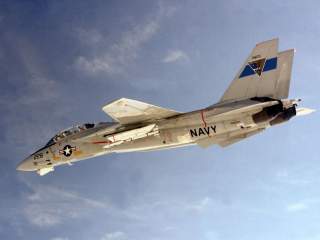America's Old F-14 Tomcats Are so Good, Iran Still Uses Them (What?)
They are vital for Tehran's defense.
The feds began investigating 18 companies that had supplied airplane components to Multicore.
In September 2003, U.S. authorities nabbed Iranian Serzhik Avasappian in a South Florida hotel as part of a sting operation. Agents had shown Avasappian several F-14 parts worth $800,000 and arrested him after he offered to buy the components.
“While these components may appear relatively innocuous to the untrained eye, they are tightly controlled for good reason,” Immigration and Customs Enforcement interim agent Jesus Torres said in a statement. “In the wrong hands, they pose a potential threat to Americans at home and abroad.”
Even with U.S. authorities tamping down on the illicit trade in F-14 parts, Iran persisted. After shutting down Multicore, the feds confiscated the firm’s Tomcat components and sent them to the Defense Department’s surplus-parts office. In 2005, a company — allegedly Iranian — bought the very same parts from the military.
The parts war escalated after the U.S. Navy retired its last F-14s in 2006, leaving Iran as the type’s only operator. In 2007, U.S. agents even seized four intact ex-U.S. Navy F-14s in California — three at museums and one belonging to a producer on the military-themed T.V. show JAG — charging that the F-14s had not been properly stripped of useful parts that could wind up in Iranian hands.
The U.S. Congress was furious at the Pentagon for its lax handling of the F-14-parts problem. Rep. Christopher Shays, a Connecticut Republican, described it as “a huge breakdown, an absolute, huge breakdown.” Lawmakers passed a bill specifically banning any trade in Tomcat components to Iran or any other entity, and then-president George W. Bush signed the law in 2008.
A minor tragedy unfolded as the military paid contractors to dismantle, crush and shred many of the approximately 150 retired F-14s. Scores of old F-14s — properly “demilitarized” — are still on display in museums across the United States. But none remain at the famous airplane “boneyard” in Arizona, where the Pentagon stores retired planes just in case it needs them again.
Even so, the underground trade in Tomcat parts continues, with shady companies scouring the planet for leftover components. In early 2014, the U.S. Department of Homeland Security investigated Israeli arms dealers that it said had twice tried to send F-14 spares to Iran.
And it’s not for no reason that Tehran would keep trying to supply its Tomcats. In recent years the United States has stepped up its efforts to spy on Iran, deploying drone aircraft including the secretive, stealthy RQ-170 to the Middle East apparently to surveil Iranian nuclear facilities. An RQ-170 crashed in Iranian territory in 2011.
Tomcats have led the effort to intercept these drones. In the early 2000s, the Iranian air force stationed an F-14 squadron in Bushehr, the site of Iran’s first nuclear reactor. That squadron eventually disbanded as its Tomcats fell into disrepair, but other F-14 squadrons maintained vigil over Bushehr and two other atomic facilities as U.S. spy flights continued to probe the sites, trying to glean intelligence on Iran’s nuclear efforts.
And that’s when things got weird. F-14 crews protecting the facilities reported seeing increasingly sophisticated and bizarre drones, according to Taghvaee. “The CIA’s intelligence drones displayed astonishing flight characteristics, including an ability to fly outside the atmosphere, attain a maximum cruise speed of Mach 10 and a minimum speed of zero, with the ability to hover over the target.”
“Finally,” Taghvaee added, “the drones used powerful [electronic countermeasures] that could jam enemy radars using very high levels of magnetic energy.” In November 2004 one F-14 crew intercepted a suspected CIA drone over the nuke facility at Arak. As the aviators tried to lock onto the drone with their Tomcat’s AWG-9 radar, they “saw that the radar scope was disrupted.” The drone lit its green afterburner and escaped.
To be clear, it’s highly unlikely the CIA possesses hypersonic space-capable drones with radar-killing magnetic ray weapons. The point is that Tehran is protective, even paranoid, when it comes to its nuclear sites — and yet entrusts their defense mainly to the 40-year-old F-14s.
Whether it’s producing parts itself or acquiring them abroad, Iran is clearly succeeding in its efforts to supply its F-14 squadrons. In October 2013, Taghvaee estimated that more than 40 of Tehran’s surviving F-14s were in flyable condition, possibly the highest number since the mid-1970s. Iran has begun upgrading the Tomcats with new radar components, radios, navigation systems and wiring while also adding compatibility with R-73 and Hawk missiles.
Five decades in, Iran’s F-14s are only getting better and better. And more and more important to the Persian state’s defense.
This first appeared several years ago.
Image: Wikimedia.

